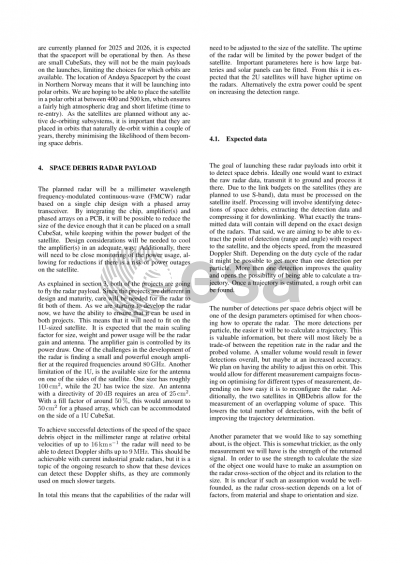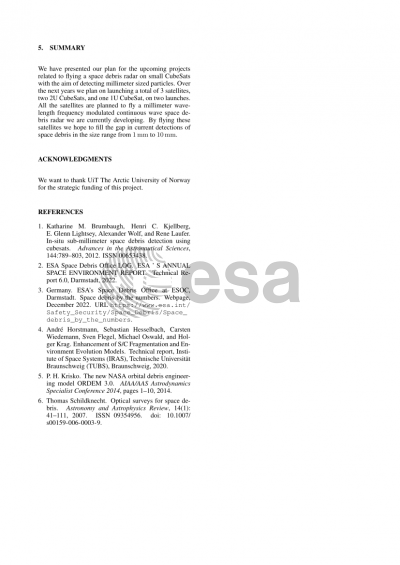Document details

Abstract
Ground based radar observations of space debris are limited to observing objects of approximately 1 cm and larger due to atmospheric attenuation. We want to present an upcoming effort aimed at detecting millimeter sized space debris in orbit using CubeSats. This effort includes two projects that together will launch three satellites equipped with small millimeter wavelength radars capable of detecting these objects. The radars will be based on as much commercial of the shelf equipment as possible, taking advantage of the rapid advance in this technology seen lately.
The first project is a university funded student satellite project aimed at
launching a 2U CubeSat in 2024/2025. Its primary aim is teaching students how to plan, design and build a satellite. The secondary aim, dependent on the satellite working in orbit, is to demonstrate the space debris radar payload, as well as some novel attitude control algorithms. From the measurements collected on the satellite we hope to be able to calculate some orbital parameters, and statistics on encounters.
The second project is a project funded by the Norwegian research council, and will launch a modified commercial 3U CubeSat, which, when in orbit, will split into a 2U and a 1U satellite. These are both equipped with the millimeter wavelength space debris radar. Launch is planed for 2025. The projects primary goal is to investigate lead–follow attitude control based on atmospheric drag. The secondary goal is to demonstrate the space debris radars and use them to detect millimeter sized space debris. By employing two satellites, measuring the same volume with the radars, it is expected that we will be able to calculate more of the orbital parameters.
The reason for wanting to put the radar in close proximity to the space debris is twofold. Firstly the close proximity to the object results in a higher
returned power, due to the R^-4 relation of the returned power with distance (R). This relationship means that even though the satellite radar will much weaker than the ground radar, the return power will be higher if the radar is close enough to the target. Secondly due to the radar scattering cross-section, the returned radar power from an object is proportional to lambda^-2. Shorter wavelengths (higher frequencies) are therefore advantageous. Millimeter wavelengths are attenuated by the Earth's atmosphere, which is avoided by putting them on the satellite.
A rough estimate based on the ORDEM model, using a radar capable of detecting a 1 mm object at 500 m gives an expected detection rate of 100 objects a day if the satellite is placed in a 400 km orbit. Even with a lower range, which is dependent on radar gain, the satellites should be able to give a useful amount of detections.
Preview





